Lang Jingshan
Lang Jingshan (Chinese: 郎靜山; 4 August 1892 – 13 April 1995), also romanized as Long Chin-san and Lang Ching-shan, was a pioneering photographer and one of the first Chinese photojournalists. He has been called "indisputably the most prominent figure in the history of Chinese art photography",[1] and the "Father of Asian Photography".[2] He joined the Royal Photographic Society in 1937 and gained his Associateship in 1940 and Fellowship in 1942.[3][4] and in 1980, the Photographic Society of America named him one of the world's top ten master photographers.[2] He was the first Chinese photographer to take artistic nude shots, and was also known for the unique "composite photography" technique he created.[2]
Lang Jingshan 郎靜山 | |
|---|---|
 Lang Jingshan, photograph by Sam Sanzetti | |
| Born | 4 August 1892 |
| Died | April 13, 1995 (aged 102) |
| Nationality | Chinese |
| Alma mater | Nanyang High School |
| Known for | Photography |
Early life and education
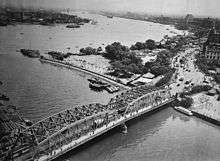
Lang Jingshan was born in Huai'an, Jiangsu province, in 1892, but was considered a native of his ancestral hometown Lanxi, Zhejiang, by Chinese convention. His father, Lang Jintang (郎錦堂), was a Qing dynasty military officer who was interested in art and photography, and Jingshan grew up influenced by the arts.[5] At age 12, while a student at Nanyang Middle School in Shanghai, he received his first training in photography from his art teacher Li Jinglan (李靖蘭), who instructed him in the principles of composition and in the techniques of photography.[5]
Career
In 1911, Lang began working for Shanghai's Shen Bao newspaper in advertising design. In 1926, he joined the Eastern Times (時報) newspaper as one of China's first photojournalists.[5] In 1928, Hu Boxiang (胡伯翔), Chen Wanli (陳萬里), and Zhang Xiuzhen (張秀珍) founded the China Photography Association, China's first art photography association, in Shanghai. Lang, Hu, and manhua artist Ding Song were key participants of the society.[5][6]
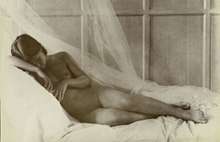
Lang's work was multifaceted. Commercial newspaper jobs made him one of China's first photojournalists, but his work in other areas put artistic values first. In 1928, he took what is considered the earliest surviving Chinese artistic nude photograph, "Meditation" (the model's father beat her when he heard what she had done).[2][7] In 1930, he published the Album of Nude Photographs, the first in China.[2] He exhibited his own work widely including After the Tang Masters in the Royal Photographic Society's 1937 Exhibition[8] and Majestic Solitude (1937) in the Royal Photographic Society's 1940 Exhibition.[9]
He experimented briefly with modernist style, such as architectural photos which emphasized abstract forms. On the other hand, the texture and composition of Lang's landscape photography drew on traditional Chinese ink painting of scenery and landscape. He achieved these effects by superimposing several images onto one print and by using a brush and ink on the print. Together with his friend, Hu Boxiang, he established several photography groups and organized a series of exhibits which also traveled to Japan, the United States, and England.[10]
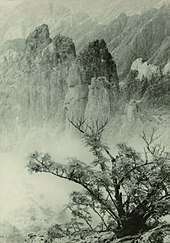
In 1939, Aurora University in Shanghai staged an exhibition of his works which demonstrated the concepts of Chinese painting in photography. When the Japanese occupied Shanghai during the Second Sino-Japanese War, he moved to inland Sichuan province, and returned to Shanghai after the war. With the Communist takeover of mainland China, he moved to Taiwan in the summer of 1949, but had to leave most of his photography equipment behind.[5] Lang cofounded the Chinese Writers’ and Artists’ Association in 1950.[11] In March 1953, the China Photography Association was reestablished in Taipei, and Lang served as its director for 42 years.[5]
Beginning in the 1960s, Lang Jingshan's photography turned to creative landscape with figures, many modeled on paintings by Zhang Daqian, showing Taoist influence. He received awards from the Ministry of Education. In 1968 he visited the United States and the Kodak factories in New York state. In 1981 and 1983 he had solo retrospectives exhibitions in France, and in 1984 in Hong Kong. The 1991 "Lang Ching-shan Centenary Exhibition" was held in Beijing at the Palace Museum.[5]
In October 2013, the National Art Museum of China (NAMOC) staged a special exhibition of Lang's art entitled "Distant Melody from Quiet Mountains".[12] Lang Jingshan's daughter, Lang Yuwen, donated 134 of his artworks, including "Meditation", to NAMOC.[2]
Style and influences
Lang committed himself to teaching and spreading his ideas of a Chinese photography. He was influenced by the pioneering photographer and literary statesman Liu Bannong, who argued as early as 1928 that China should have its own style rooted in Chinese culture.[13] In turn he and his style influenced such younger photographers as Liu Xucang, and Tchan Fou-li, who worked in Hong Kong. He published an important article titled 'Composite Pictures and Chinese Art' in the Royal Photographic Society's Journal in February 1942 which reproduced and discussed his photograph Au Printemps.[14]
Personal life
Lang married four times and had fifteen sons and daughters. He died on 13 April 1995 in Taipei at the age of 102.[15]
Selected works
 美人胡为隔秋水, 1932
美人胡为隔秋水, 1932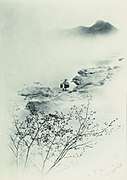 Drawing Water from the River at Dawn, 1934
Drawing Water from the River at Dawn, 1934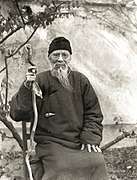 Portrait of Qi Baishi, 1930s
Portrait of Qi Baishi, 1930s Mooring in the Misty River at Night, 1937
Mooring in the Misty River at Night, 1937
See also
Notes
- Lai, Kin-Keung Edwin; Lang, Jingshan (2000). The Life and Art Photography of Lang Jingshan (1892–1995). University of Hong Kong. doi:10.5353/th_b3023021.
- Zhang Junmian (2013-11-29). "China's first nude photographer". China.org.cn.
- Information from the Royal Photographic Society's membership records supplied by the Director-General. Lang Jingshan became a Life Member of The RPS in 1967.
- Dikötter 2008, p. 76.
- Zhou Yuling (周郁齡) (October 2003). "一個世紀的見證-郎靜山其人與其藝" [Witness of a century: Lang Jingshan and his art] (PDF). National Chi Nan University.
- Roberts (2012), p. 83.
- Roberts (2012), p. 85.
- Number 69 listed in 'Catalogue', Photographic Journal, 1937.
- The image was reproduced in the exhibition catalogue, The Year's Photography 1940-1941, plate XIV.
- Kent (2013).
- Han Cheung (14 April 2019). "Taiwan in Time: Master artist in exile". Taipei Times. Retrieved 14 April 2019.
- Sue Wang (October 23, 2013). "'Distant Melody from Quiet Mountains – Special Exhibition of Lang Ching-shan Photography Art' Debut at National Art Museum of China". CAFA Art Info. Archived from the original on March 4, 2016. Retrieved May 25, 2014.
- LO Yan-yan "Tchan Fou-li: Inventing Hong Kong Pictorial Photography with the Charm of Chinese Culture Archived 2012-09-05 at the Wayback Machine"
- Chin-San Long FRPS, 'Composite Pictures and Chinese Art', Photographic Journal, February 1942, pp. 30-32.
- 郎靜山年表與語錄 (Lang Jingshan chronological biography and quotes), Image (影像) Magazine, issue 14 (May 1995), p. 48
References and further reading
- Lai, Kin-keung, Edwin. 黎健強, "The life and art photography of Lang Jingshan (1892–1995)," PhD Thesis, Fine Arts Department, The University of Hong Kong (Pokfulam, Hong Kong doi) (May be viewed for free by registering).
- Dikötter, Frank (2008). The Age of Openness: China Before Mao. University of California Press. ISBN 978-0-520-25881-5.CS1 maint: ref=harv (link)
- Kent, Richard K (2013). "Early Twentieth-Century Art Photography in China: Adopting, Domesticating, and Embracing the Foreign". Local Culture/Global Photography. 3 (2). hdl:2027/spo.7977573.0003.204.CS1 maint: ref=harv (link)
- Roberts, Claire (2012). Photography and China (Exposures). Durrington, UK: Reaktion Books. ISBN 9781861899118.CS1 maint: ref=harv (link)
External links
| Wikimedia Commons has media related to Lang Jingshan. |
- Photography of Lang Jingshan Includes a gallery showing the range of Lang's styles over the decades.
- Lang Jingshan (in Chinese) Click on links near the bottom of the page to view an extensive selection of Lang's work.